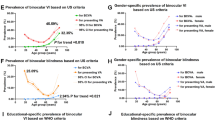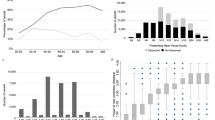Abstract
Background/Objective
To determine the prevalence of visual impairment (VI), uncorrected refractive errors (URE), and effective refractive error coverage among individuals aged 15–50 years in Koshi Province, Nepal.
Methods
A population-based cross-sectional study was conducted in Koshi Province in which 4800 participants were selected from 80 clusters. The study teams visited the selected households and conducted eye examinations. This included monocular unaided (and aided) visual acuity assessment using a Snellen chart with tumbling E optotypes at a distance of 6 meters. Near vision was assessed binocularly using the N notation chart at a fixed distance of 40 cm for each individual. Torchlight examination and distance direct ophthalmoscopy was done. VI was defined as presenting visual acuity worse than 6/12 in the better eye. URE was defined as presenting visual acuity worse than 6/12 and improving to 6/12 or better on using a pinhole. Near Vision Impairment was defined as binocular presenting near vision worse than N8 among those age 35 years and older.
Results
In total, 4057 were examined (84.5% response rate). The prevalence of VI was 3.52% (95% CI:2.89–4.13; n = 143). The prevalence of URE in the better eye was 1.95% (95% CI:1.54–2.42; n = 79). The Refractive Error Coverage and Effective Refractive Error Coverage were 34.8% and 31.3% respectively. The prevalence of NVI was 34.24% (95% CI: 32.1–36.40; n = 666).
Conclusion
The prevalence of VI and URE was low, attributed to the availability and uptake of services in Koshi province in Nepal.
This is a preview of subscription content, access via your institution
Access options
Subscribe to this journal
Receive 18 print issues and online access
$259.00 per year
only $14.39 per issue
Buy this article
- Purchase on Springer Link
- Instant access to full article PDF
Prices may be subject to local taxes which are calculated during checkout


Similar content being viewed by others
Data availability
The data that support the findings of this study are not openly available as authors are analyzing the data for other manuscripts. Data are available from the corresponding author upon reasonable request.
References
Bourne R, Steinmetz JD, Flaxman S, Briant PS, Taylor HR, Resnikoff S, et al. Trends in prevalence of blindness and distance and near vision impairment over 30 years: an analysis for the Global Burden of Disease Study. Lancet Glob Health. 2021;9:e130–43.
Steinmetz JD, Bourne RR, Briant PS, Flaxman SR, Taylor HR, Jonas JB, et al. Causes of blindness and vision impairment in 2020 and trends over 30 years, and prevalence of avoidable blindness in relation to VISION 2020: the Right to Sight: an analysis for the Global Burden of Disease Study. Lancet Glob Health. 2021;9:e144–60.
Marmamula S, Keeffe JE, Rao GN. Rapid assessment methods in eye care: an overview. Indian J Ophthalmol. 2012;60:416–22.
Marmamula S, Keeffe JE, Rao GN. Uncorrected refractive errors, presbyopia and spectacle coverage: results from a rapid assessment of refractive error survey. Ophthalmic Epidemiol. 2009;16:269–74.
McCormick I, Mactaggart I, Bastawrous A, Burton MJ, Ramke J. Effective refractive error coverage: an eye health indicator to measure progress towards universal health coverage. Ophthalmic Physiol Opt. 2020;40:1–5.
Luque LC, Naidoo K, Chan VF, Silva JC, Naduvilath TJ, Peña F, et al. Prevalence of refractive error, presbyopia, and spectacle coverage in Bogota, Colombia: a rapid assessment of refractive error. Optom Vis Sci. 2019;96:579–86.
Mashayo ER, Chan VF, Ramson P, Chinanayi F, Naidoo KS. Prevalence of refractive error, presbyopia and spectacle coverage in Kahama District, Tanzania: a rapid assessment of refractive error. Clin Exp Optom. 2015;98:58–64.
Muhit M, Minto H, Parvin A, Jadoon MZ, Islam J, Yasmin S, et al. Prevalence of refractive error, presbyopia, and unmet need of spectacle coverage in a northern district of Bangladesh: Rapid Assessment of Refractive Error study. Ophthalmic Epidemiol. 2018;25:126–32.
Nsubuga N, Ramson P, Govender P, Chan V, Wepo M, Naidoo KS. Uncorrected refractive errors, presbyopia and spectacle coverage in Kamuli District, Uganda. Afr Vision Eye Health. 75;2016;75:1-6.
Loughman J, Nxele LL, Faria C, Thompson S, Ramson P, Chinanayi F, et al. Rapid assessment of refractive error, presbyopia, and visual impairment and associated quality of life in Nampula, Mozambique. J Vis Impair Blind. 2015;109:199–212.
Naidoo KS, Chinanayi FS, Ramson P, Mashige KP. Rapid assessment of refractive error in the eThekwini Municipality of KwaZulu-Natal, Durban, South Africa. Clin Exp Optom. 2016;99:360–5.
Chan VF, Mebrahtu G, Ramson P, Wepo M, Naidoo KS. Prevalence of refractive error and spectacle coverage in Zoba Ma’ekel Eritrea: a rapid assessment of refractive error. Ophthalmic Epidemiol. 2013;20:131–7.
Marmamula S, Khanna RC, Kunkunu E, Rao GN. Population-based assessment of prevalence and causes of visual impairment in the state of Telangana, India: a cross-sectional study using the Rapid Assessment of Visual Impairment (RAVI) methodology. BMJ Open. 2016;6:e012617.
Bourne RR, Cicinelli MV, Sedighi T, Tapply IH, McCormick I, Jonas JB, et al. Effective refractive error coverage in adults aged 50 years and older: estimates from population-based surveys in 61 countries. Lancet Glob Health. 2022;10:e1754–63.
McCormick I, Mactaggart I, Resnikoff S, Muirhead D, Murthy GV, Silva JC, et al. Eye health indicators for universal health coverage: results of a global expert prioritisation process. Br J Ophthalmol. 2022;106:893–901.
Marmamula S, Khanna RC, Narsaiah S, Shekhar K, Rao GN. Prevalence of spectacles use in Andhra Pradesh, India: rapid assessment of visual impairment project. Clin Exp Ophthalmol. 2014;42:227–34.
Mashayo ER, Chan VF, Ramson P, Chinanayi F, Naidoo KSJC, Optometry E. Prevalence of refractive error, presbyopia and spectacle coverage in Kahama District, Tanzania: a rapid assessment of refractive error. Clin Exp Optom. 2015;98:58–64.
World Health Organization (WHO). 74th World Health Assembly Resolution. Geneva: WHO; 2021.
Acknowledgements
We express our gratitude to Dr Chet Raj Pant, Chairman and Dr Sailesh Mishra, Executive Director of NNJS for valuable guidance and support. Mr. Kumar Prithu, Hospital Manager, Md. Rafique, Mr. Dipendra Chaudhary of BEH for logistics and HR support. The Ophthalmic Assistants (Sabin Kumar Mahato, Bijay Tamang, Indrajeet Kumar Yadav, Shivram Chaudhary) and Community Eye Health Workers (Rita Pradhan, Parshuram Shrestha, Shrawn Majhi, Manish Khawash), Optometrists (Pankaj Ray Adhikari and Sanjay Kumar Shah), Similarly, Dhiraj Mandal, Gautam Majhi, Mithlesh Meheta, Rupesh Kumar, Sanjay Kamat are acknowledged for their contributions.
Funding
This study was funded by OneSight Essilor Luxottica Foundation, USA.
Author information
Authors and Affiliations
Contributions
Study concept and design: SM. Acquisition, analysis, or interpretation of data: RRK, RSH, AKM, SM. Drafting of the manuscript: RRK, SM, RSA. Critical revision of the manuscript for important intellectual content: SS, RSH, SKT, RPS. Statistical analysis: SM, RRK.
Corresponding author
Ethics declarations
Competing interests
The authors declare no competing interests.
Additional information
Publisher’s note Springer Nature remains neutral with regard to jurisdictional claims in published maps and institutional affiliations.
Rights and permissions
Springer Nature or its licensor (e.g. a society or other partner) holds exclusive rights to this article under a publishing agreement with the author(s) or other rightsholder(s); author self-archiving of the accepted manuscript version of this article is solely governed by the terms of such publishing agreement and applicable law.
About this article
Cite this article
Karn, R.R., Marmamula, S., Thakur, S.K. et al. Prevalence of visual impairment, uncorrected refractive errors and effective refractive error coverage in Koshi Province, Nepal - Rapid Assessment of Refractive Errors. Eye (2023). https://doi.org/10.1038/s41433-023-02786-4
Received:
Revised:
Accepted:
Published:
DOI: https://doi.org/10.1038/s41433-023-02786-4



